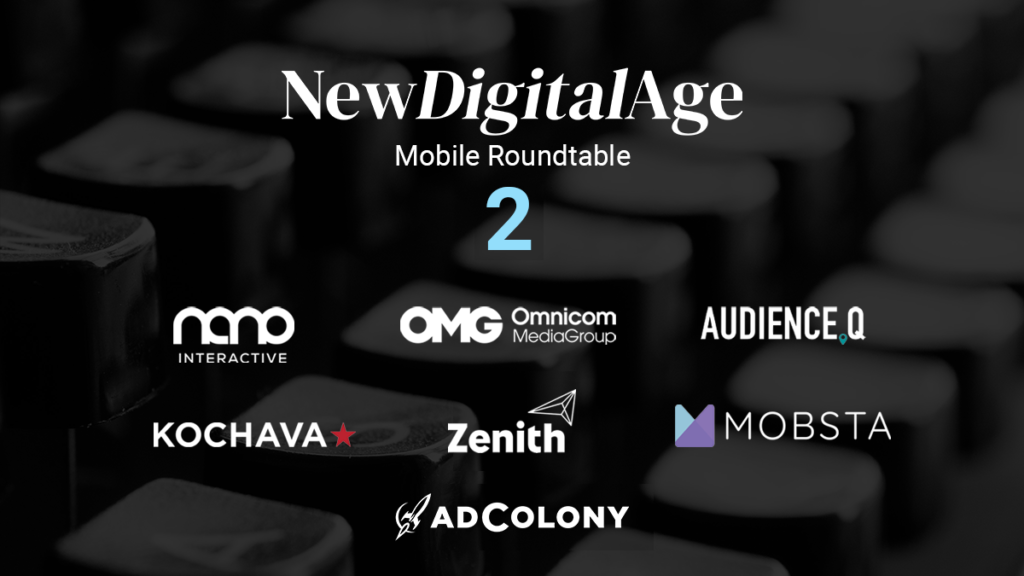Mobile is the great enabler, according to practitioners working in the industry today – with the ability to connect both the physical and the digital as well as inform every advertising channel available to marketers.
It has also been given greater prominence as an advertising medium and a data tool following the Coronavirus pandemic and alongside changes in digital regulation and rule changes, both from the browsers and governments. The pandemic, too, has ushered in a new age of innovation they say.
New Digital Age Editor Justin Pearse brought together Niall Moody, Managing Director, Nano Interactive; Phil Rowley, Head of Futures at Omnicom Media Group (OMG); Ken Parnham, Co-Founder of AudienceQ; Natalie Carder, Head of Paid Social at Zenith Global; Charles Manning, CEO of Kochava; Will Dorling, UK Director of Sales at AdColony and George Dixon, Head of Product and Strategy at Mobsta to debate the changing mobile landscape.
Says Manning: “There’s this really interesting melding between TV, CTV, OTT and mobile in that, for the first time, you can expose an audience on TV, and then see the action happen on a mobile device. And because of some of the innovation around identity tools, and cross device tools, there’s now a capacity for a brand to connect those dots.”
Location is another “white hot item”, he adds. “Even in the midst of a lockdown initiatives such as contactless payment and contactless pickup are important things.
“We’re seeing an awful lot of brands who are caring about visitation in the context of exposure that’s happening on CTV. There’s a really interesting convergence between technologies and components that use identity and identity graphs. It uses location in the way we were traditionally thinking about it before this last year, but also using it just in the context of multi-channel exposure.”
However, he cautions that the use of location around “data for good”, for instance COVID track and trace services, has made some people “nervous” despite the fact that their data was private and protected.
Dorling uses a personal example to illuminate how mass communication and awareness building by the government has been achieved at scale via an app. He says: “Having been told that I was in proximity to someone who tested positive and then having to self-isolate as a result is an interesting concept and only made possible because of mobile and an app and location data.”
Data is mobile’s biggest differentiator, according to Dixon, as well as marketing’s biggest opportunity, even as – or perhaps because of – the new layers of privacy regulations and innovations from governments and the likes of Google and Apple.
In fact, he believes the “dumbing down” of how marketers and their partners collect and use data in the digital space will be a good thing – not a negative.
Dixon says: “We’ve been doing a lot of work in informing offline channels, such as out of home, and we recently launched an addressable TV measurement solution that exists without device ID, because we see the value in understanding the movements of large numbers of people and big anonymous data sets as well as individual devices. “
He continues: “This is a real opportunity for the ad industry to think to merge the accountability of digital and bring it back to where addressable TV and connected TV and digital at home are getting to.”
Carder adds that mobile, with all its signals, “really is the best tool to be able to understand your audience, where they are in that conversion journey, and make sure that we’re sending them relevant and timely messaging”. She continues: “The biggest question is whether or not brands will still be able to unite all these signals into one, single customer view in a post-cookie, post-IDFA world.”
Most of our panelists agree, with Parnham saying that mobile’s most exciting role was that of “data gatherer”. “If, in a GDPR-compliant way, you can extrapolate that information out and turn it into an insight you’re giving brands more information as to how they can serve better media mixes and discover where that customer is in the funnel.”
However, he cautions that although GDPR has done “a world of good for the industry it has also been quite negative in that it was supposed to get rid of the bad actors.” He continues: “Actually, what it has done is create two big bad actors because the duopoly of Google and Facebook is using that as an excuse to say ‘we can’t play with you any more’.”
Manning is similarly damning of some of the measures put in place, although he believes it will lead to a “renaissance” in the industry.
Talking particularly about Apple’s SKAdNetwork, a framework for privacy-preserving mobile install attribution, he says: “It’s an approach that balances marketing feedback decoupled from non-consented consumer engagement designed to honor the evolving consumer privacy landscape. Understanding this important market shift, we have developed a SKAdNetwork omni-channel attribution solution across all devices and platforms that provides the most holistic marketing and media mix optimization.”
He says the implication is that brands are not signing up to figure out how they implement SKAdNetwork conformance for all of their media campaigns. “Tools like ours and like others on this panel have to think about what it means to have SKAdNetwork signals as a proxy, as opposed to device IDs, with record level insight.
“But I also think it’s going to really create a Renaissance. Sometimes when you have a force change that’s as significant as this, you end up really rethinking things.”
There are mixed views on how far Apple’s moves to make users consent to sharing data with advertisers on every app they download will move the needle. Dorling believes, as with cookie consent, most will simply press ‘yes’ for ease, while Rowley notes the after-effects of this month’s Capitol riots.
Rowley says: “Look at how in the immediate aftermath of the Capitol riots the number of P2P and super-encrypted communications platforms rocketed up the app charts. Whilst it’s true that a lot of people will just click ‘yes, accept’, if there is a groundswell of people who become increasingly aware of how much they are tracked, or they feel they are tracked, we shouldn’t rest on our laurels and be complacent.”
For Moody, 2020 was a year of reflection and innovation. He says: “We were forced to spend a lot of time on introspection. Certainly for us as a company, we looked at how we could do things better. I don’t think there’s ever really been a more exciting time.”
Everywhere you look, he says, there are people pushing innovation, whether or not you agreed with their premise for doing so.
The rapid changes are forcing a rethink around measurement. Says Manning: “There’s a real curiosity and interest in understanding omni channel and multi touch, this resurgence of wanting to understand the truth again and then there’s almost a blockheaded perspective of ‘Just give me the last click so I can give someone credit and I can put money someplace’.”
He adds: “I know that when you’re a hammer, everything’s a nail, but this is an exciting time because everything is changing in terms of measurement.”
There are lessons to be learnt from traditional channels, perhaps. Dorling says: “I’m from a data background but I’m a big believer in the power of context and content, that broad reach of advertising being able to change opinions because you are in the right place, rather than trying to necessarily target Billy with a red hat who lives in Slough.
“TV’s always managed to make a great business out of that valuable wastage that they deliver. And I think digital almost needs to get back to some of that. The mobile is a device that everyone uses and spends a lot of time on, and for a lot of advertisers that’s almost enough. You can do a lot without having the most granular data so for some areas of our business, particularly brand, releasing the shackles of data will be really interesting to see.”
Dixon agrees. “I like this idea of softer, but still important, metrics and moving away from CTR and so on. We could become focused more on the accuracy of reaching an audience, the reduction in fraud, the increase in viewability, and digital should be held to those similar standards that you’d expect from TV campaign or an out of home campaign.
“It could be just the dwell time on my website goes up as a result of the entire cross channel campaign. Did I see more foot traffic into all of my stores, did I steal share a voice digitally or in the real world? Those kind of metrics have always been a challenge but now it is so much more feasible.”
And, as Moody says: “I think it’s possible, in fact we’ve demonstrated, that you don’t need to have identity in place to prove that the advertising you’ve run has been effective.”









